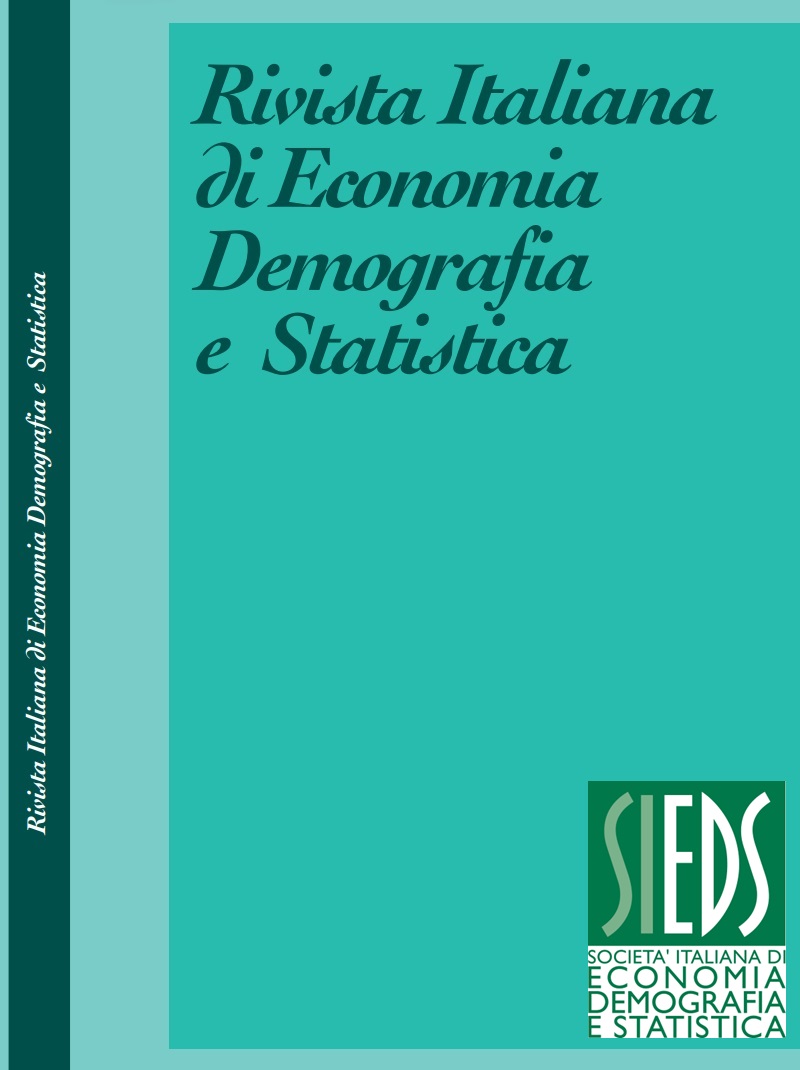Gender disparities in school-to-university transition in Italy: the role played by the socio-economic condition and the type of high school
DOI:
https://doi.org/10.71014/sieds.v79i1.351Abstract
The issue of the gender gap in university enrolment is widely investigated, and it is acknowledged that the school-to-university transition tends to be higher for female students than for males. Gender inequalities in access to the higher education system could derive from the persistence and transmission of gender disparities relying on several factors; in particular, in this work, we intend to assess potential gender inequalities in the school-to-university transition, which could be moderated by different students’ socioeconomic conditions or type of high school. Using the integration between two administrative data sources, the INVALSI database and the Anagrafe Nazionale Studenti (ANS) database, our final dataset comprises a total of 420,261 students of grade 13 who graduated in the school year 2018/2019, of which 215,565 are females (51.3%). Among those, 52.6% of all students enrolled in the following 2019/2020 academic year.
Our results suggest that the proportion of female students enrolling in university is consistently higher than that of male students, regardless of the type of diploma or the socioeconomic conditions of the family of origin. Nevertheless, the gender disparity in the school-to-university transition is more pronounced among students coming from technical and vocational high schools and among those with low/middle socioeconomic and cultural status, leaving male students with less prestigious backgrounds even further behind.
References
AINA C., BAICI E., CASALONE G. 2011. Time to a degree: students’ abilities, university characteristics or something else? Evidence from Italy, Education Economics, Vol. 19, No. 3, pp. 311–325. DOI: https://doi.org/10.1080/09645292.2011.585016
BARONE C., ASSIRELLI G. 2020. Gender segregation in higher education: an empirical test of seven explanations, Higher Education, Vol. 79, No. 1, pp. 55–78. DOI: https://doi.org/10.1007/s10734-019-00396-2
BARRO R.J. 2013. Education and Economic Growth, Annals of Economics and Finance, Vol. 14, No. 2, pp. 301–328.
BARTEL A.P., LICHTENBERG F.R. 1987. The Comparative Advantage of Educated Workers in Implementing New Technology, The Review of Economics and Statistics, Vol. 69, No. 1, p. 1. DOI: https://doi.org/10.2307/1937894
BLETSAS A., MICHELL D. 2014. Classism on campus? Exploring and extending understandings of social class in the contemporary higher education debate. In BROOK H., FERGIE D., MAEORG M., MICHELL D. (Eds.) Universities in Transition: Foregrounding Social Contexts of Knowledge in the First Year Experience, University of Adelaide Press, pp. 77–96. DOI: https://doi.org/10.20851/universities-transition-03
BORGNAC., STRUFFOLINO E. 2017. Pushed or pulled? Girls and boys facing early school leaving risk in Italy, Social Science Research, Vol. 61, pp. 298–313. DOI: https://doi.org/10.1016/j.ssresearch.2016.06.021
BRADLEY D., NOONAN P., NUGENT H., SCALES B. 2008. Review of Australian higher education: final report. Canberra, A.C.T.
BREEN R., LUIJKX R., MÜLLER W., POLLAK R. 2010. Long-term Trends in Educational Inequality in Europe: Class Inequalities and Gender Differences, European Sociological Review, Vol. 26, No. 1, pp. 31–48. DOI: https://doi.org/10.1093/esr/jcp001
BRIGGS A.R.J., CLARK J., HALL I. 2012. Building bridges: understanding student transition to university, Quality in Higher Education, Vol. 18, No. 1, pp. 3–21. DOI: https://doi.org/10.1080/13538322.2011.614468
BYNNER J., DOLTON P., FEINSTEIN L., MAKEPEACE G., MALMBERG L., WOODS L. 2002. Revisiting the Benefits of Higher Education.
CABRAS C., MONDO M. 2018. Coping strategies, optimism, and life satisfaction among first-year university students in Italy: gender and age differences, Higher Education, Vol. 75, No. 4, pp. 643–654. DOI: https://doi.org/10.1007/s10734-017-0161-x
CONTINI D., CUGNATA F., SCAGNI A. 2018. Social selection in higher education. Enrolment, dropout and timely degree attainment in Italy, High Educ, Vol. 75, No. 5, pp. 785–808. DOI: https://doi.org/10.1007/s10734-017-0170-9
COUNCIL OF THE EUROPEAN UNION. 2021. Council Resolution on a strategic framework for European cooperation in education and training towards the European Education Area and beyond (2021-2030), 2021/C 66/01.
DEVLIN M., MCKAY J. 2014. Reframing “the problem”: students from low socio-economic status backgrounds transitioning to university. In BROOK H., FERGIE D., MAEORG M., MICHELL D. (Eds.) Universities in Transition: Foregrounding Social Contexts of Knowledge in the First Year Experience, University of Adelaide Press, pp. 97–126. DOI: https://doi.org/10.20851/universities-transition-04
EUROSTAT. 2024. Population by educational attainment level, sex, age and citizenship (%), Online data code: edat_lfs_9911, Last data update: 13/06/2024.
GREEN A., PRESTON J. 2001. Education and Social Cohesion: Recentering the Debate, Peabody Journal of Education, Vol. 76, No. 3/4, pp. 247-284. DOI: https://doi.org/10.1080/0161956X.2001.9682001
KLEEMOLA K., HYYTINEN H., TOOM A. 2023. Critical thinking and writing in transition to higher education in Finland: do prior academic performance and socioeconomic background matter?, European Journal of Higher Education, Vol. 13, No. 4, pp. 488–508. DOI: https://doi.org/10.1080/21568235.2022.2075417
LIPS H.M. 2004. The Gender Gap in Possible Selves: Divergence of Academic Self-Views Among High School and University Students, Sex Roles, Vol. 50, No. 5/6, pp. 357–371. DOI: https://doi.org/10.1023/B:SERS.0000018891.88889.c9
MCGHIE V. 2017. Entering university studies: identifying enabling factors for a successful transition from school to university, High Educ, Vol. 73, No. 3, pp. 407–422. DOI: https://doi.org/10.1007/s10734-016-0100-2
TRIVENTI M. 2010. Something changes, something not. Long-term trends in gender segregation of fields of study in Italy, Italian Journal of Sociology of Education, Vol. 2, No. 2, pp. 47-80.
Downloads
Published
Issue
Section
License
Copyright (c) 2025 Valentina Tocchioni, Samuele Milone, Gabriele Lombardi

This work is licensed under a Creative Commons Attribution 4.0 International License.



